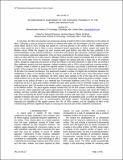An Independent Assessment of the Technical Feasibility of the Mars One Mission Plan
Author(s)
Do, Sydney; Ho, Koki; Schreiner, Samuel Steven; Owens, Andrew Charles; de Weck, Olivier L.
Downloadde Weck-An independent.pdf (1.937Mb)
OPEN_ACCESS_POLICY
Open Access Policy
Creative Commons Attribution-Noncommercial-Share Alike
Terms of use
Metadata
Show full item recordAbstract
In mid-2012, the Mars One program was announced, aiming to build the first human settlement on the surface of Mars. Following a series of precursor missions to develop and deploy key technologies, the first crewed mission would depart Earth in 2024, sending four people on a one-way journey to the surface of Mars. Additional four-person crews would be sent to Mars at every subsequent launch opportunity to further support and expand the Martian colony. While this program has been received with great fanfare, very little has been published in the technical literature on this mission architecture. As the Mars One mission plan represents a dramatic departure from more conservative exploration approaches, there are many uncertainties in the mission design. The establishment of a colony on Mars will rely on in-situ resource utilization (ISRU) and life support technologies that are more capable than the current state of the art. Moreover, resupply logistics and sparing will play a large role in the proposed colony, though the magnitude and behavior of these two effects is not well understood. In light of this, we develop a Mars settlement analysis tool that integrates a habitat simulation with an ISRU sizing model and a sparing analysis. A logistics model is utilized to predict the required number of launchers and provide a preliminary estimate of a portion of the program cost. We leverage this tool to perform an independent assessment of the technical feasibility of the Mars One mission architecture. Our assessment revealed a number of insights into architecture decisions for establishing a colony on the Martian surface. If crops are used as the sole food source, they will produce unsafe oxygen levels in the habitat. Furthermore, the ISRU system mass estimate is 8% of the mass of the resources it would produce over a two year period. That being said, the ISRU technology required to produce nitrogen, oxygen, and water on the surface of Mars is at a relatively low Technology Readiness Level (TRL), so such findings are preliminary at best. A spare parts analysis revealed that spare parts quickly come to dominate resupply mass as the settlement grows: after 130 months on the Martian surface, spare parts compose 62% of the mass brought from Earth to the Martian surface. The space logistics analysis revealed that, for the best scenario considered, establishing the first crew for a Mars settlement will require approximately 15 Falcon Heavy launchers and require $4.5 billion in funding, and these numbers will grow with additional crews. It is important to note that these numbers are derived only when considering the launch of life support and ISRU systems with spare parts. To capture a more realistic estimate of mission cost, future work should consider development and operations costs, as well as the integration of other key mission elements, such as communications and power systems. Technology development towards improving the reliability of life support systems, the TRL of ISRU systems, and the capability of Mars in-situ manufacturing will have a significant impact on reducing the mass and cost of Mars settlement architectures.
Date issued
2014-09Department
Massachusetts Institute of Technology. Department of Aeronautics and Astronautics; Massachusetts Institute of Technology. Engineering Systems DivisionJournal
Proceedings of the 65th International Astronautical Congress
Publisher
International Astronautical Federation
Citation
Do, Sydney, Koki Ho, Samuel Steven Schreiner, Andrew Charles Owens, and Olivier L. de Weck. "An Independent Assessment of the Technical Feasibility of the Mars One Mission Plan." 65th International Astronautical Congress, Toronto, Canada, September 29-October 3, 2014.
Version: Author's final manuscript